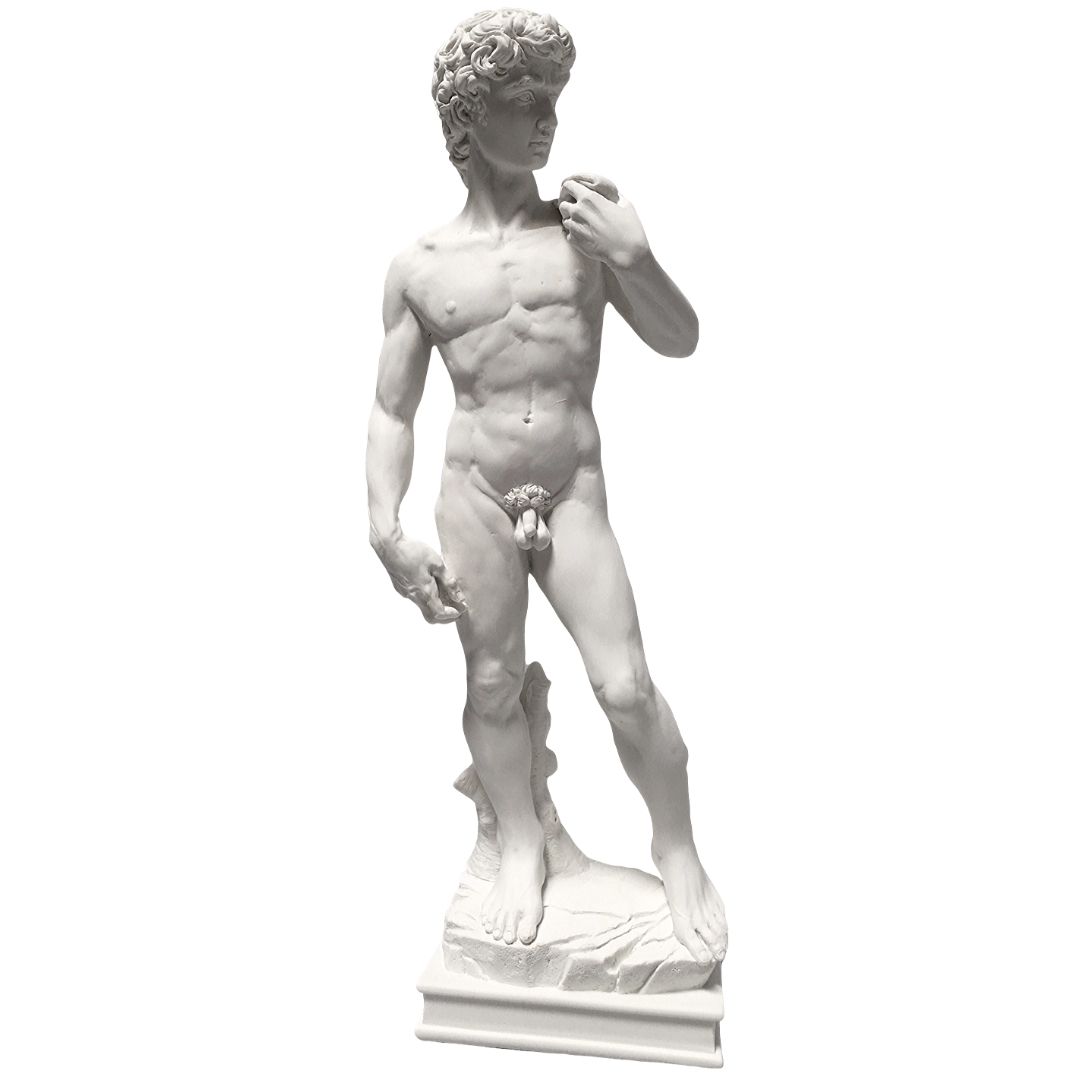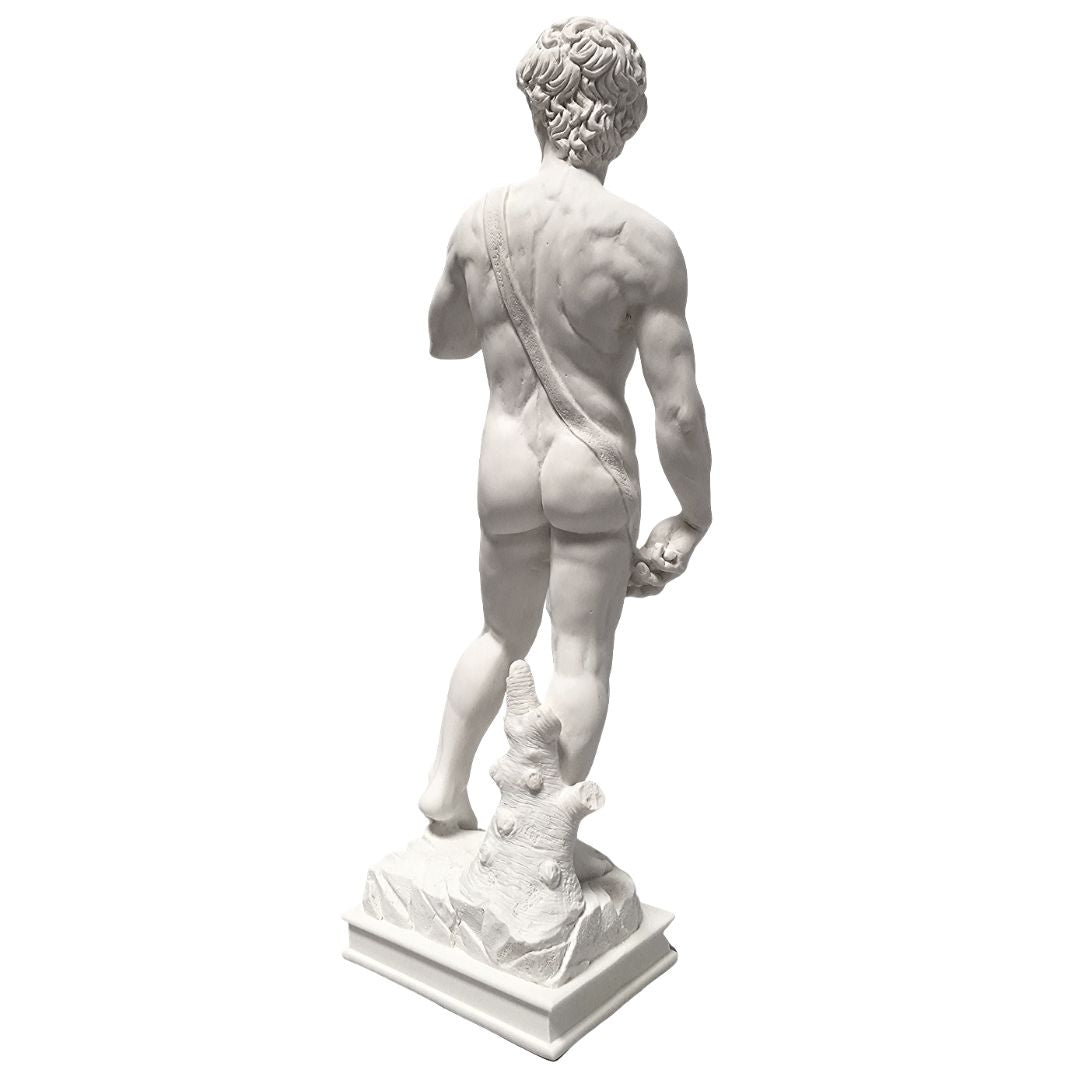1
/
of
4
Parastone
David Florentine Renaissance Hero Statue by Michelangelo
David Florentine Renaissance Hero Statue by Michelangelo
SKU:MIC04
Regular price
$72.25 USD
Regular price
Sale price
$72.25 USD
Unit price
/
per
Shipping calculated at checkout.
In stock
Couldn't load pickup availability
Item Specifics
Item Specifics
- Dimensions (in): 10.5 in H x 3.75 in W x 2.5 in D
- Weight: 1.4 lb
- Material: resin with subtle gray veins
- Item type: Michelangelo Statue
- UPC or EAN: 8717202559862
Michelangelo's David (1501-1504):
This Italian Renaissance masterpiece, The David, has a remarkable history. At the start of the 15th century, the governors of the Cathedral of Florence decided to commission twelve large Old Testament figures installed along the edge of the Santa Maria del Fiore's roof. When, decades later, it was the figure of the David's turn, a huge, expensive block of Carrara marble was purchased. After various artists had failed to complete the enormous job, the still rough block lay untouched for 25 years, at the mercy of the elements. Until Michelangelo, then only twenty-six years old, managed to convince the principals that he could turn it into something. To everyone's surprise, the sculptor was finished after two years of hard work. However, it proved too heavy weighing six tons and too vulnerable to be hoisted up to the roof of the cathedral. It was therefore decided to place the widely praised masterpiece at the entrance to the Pallazo Vecchio, where the city council met. There it symbolized the defense of the citizens' rights of Florence against the authoritarian city states located nearby. The athletic young man's large head and hands were conspicuous. It is generally assumed that Michelangelo exaggerated these because he assumed the sculpture on the roof of the cathedral would only be seen from below.
This reproduction of the The David by Michelangelo is part of the Parastone Museum Collection. Made from resin, white with subtle grey veins to evoke marble, description card included, and measures 10.5"H x 3.75"W x 2.5"D.
Michelangelo, Italian Master (1475-1564):
As an artist, sculptor, architect and poet Michelangelo di Lodovico Buonarroti Simoni was the archetype of the Renaissance artist, the universal man (uomo universale).
As the son of the mayor of Caprese he spent all his time drawing, much to his father's chagrin. His mother died young and he was raised by a nanny who was married to a sculptor. Michelangelo proved to be so talented that as a fifteen year old he was noticed by the powerful artists' patron Lorenzo de Medici. His creativity and work ethic were unstoppable. He sculpted two of his most famous works before he was 30: The Pieta and the colossal sculpture of The David.
A number of years later, he had made such a name for himself that Pope Julius II asked him to paint the ceiling of the Sistine Chapel. The artist spent four long years painting the frescoes which garnered admiration from all for their emotional expressiveness their terribilita. His ground breaking style was later considered the inspiration for Mannerism. ll Divino was a living legend, the first artist to have a biography written about him whilst still alive. However, he was not a pleasant human. Contemporaries described him a manic, rough, arrogant and sober living, grumpy man, who only lived for his art.
Part of the meticulously detailed museum collection by Parastone Mouseion 3D.
This Italian Renaissance masterpiece, The David, has a remarkable history. At the start of the 15th century, the governors of the Cathedral of Florence decided to commission twelve large Old Testament figures installed along the edge of the Santa Maria del Fiore's roof. When, decades later, it was the figure of the David's turn, a huge, expensive block of Carrara marble was purchased. After various artists had failed to complete the enormous job, the still rough block lay untouched for 25 years, at the mercy of the elements. Until Michelangelo, then only twenty-six years old, managed to convince the principals that he could turn it into something. To everyone's surprise, the sculptor was finished after two years of hard work. However, it proved too heavy weighing six tons and too vulnerable to be hoisted up to the roof of the cathedral. It was therefore decided to place the widely praised masterpiece at the entrance to the Pallazo Vecchio, where the city council met. There it symbolized the defense of the citizens' rights of Florence against the authoritarian city states located nearby. The athletic young man's large head and hands were conspicuous. It is generally assumed that Michelangelo exaggerated these because he assumed the sculpture on the roof of the cathedral would only be seen from below.
This reproduction of the The David by Michelangelo is part of the Parastone Museum Collection. Made from resin, white with subtle grey veins to evoke marble, description card included, and measures 10.5"H x 3.75"W x 2.5"D.
Michelangelo, Italian Master (1475-1564):
As an artist, sculptor, architect and poet Michelangelo di Lodovico Buonarroti Simoni was the archetype of the Renaissance artist, the universal man (uomo universale).
As the son of the mayor of Caprese he spent all his time drawing, much to his father's chagrin. His mother died young and he was raised by a nanny who was married to a sculptor. Michelangelo proved to be so talented that as a fifteen year old he was noticed by the powerful artists' patron Lorenzo de Medici. His creativity and work ethic were unstoppable. He sculpted two of his most famous works before he was 30: The Pieta and the colossal sculpture of The David.
A number of years later, he had made such a name for himself that Pope Julius II asked him to paint the ceiling of the Sistine Chapel. The artist spent four long years painting the frescoes which garnered admiration from all for their emotional expressiveness their terribilita. His ground breaking style was later considered the inspiration for Mannerism. ll Divino was a living legend, the first artist to have a biography written about him whilst still alive. However, he was not a pleasant human. Contemporaries described him a manic, rough, arrogant and sober living, grumpy man, who only lived for his art.
Part of the meticulously detailed museum collection by Parastone Mouseion 3D.
Share








